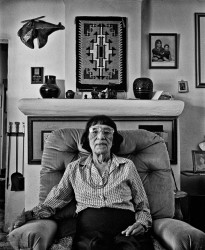Article Origin
Volume
Issue
Year
Pioneering painter earned fame for creating childhood images
Initially ostracized by the leaders of her Santa Clara Pueblo in New Mexico for pursuing a full-time career as a painter, Pablita Velarde ignored criticism and went on to exhibit her work throughout the United States and Europe.
In the 1940s, when women were expected to be potters, selling their work at local trading posts, art fairs and roadside stands, Velarde disregarded custom to become a leading professional American Indian artist, capturing everyday and ceremonial life from her childhood.
“My grandmother was born absolutely dirt poor and she survived the school of hard knocks,” said granddaughter Margarete Bagshaw, a successful painter and Santa Fe gallery owner herself. “She and her sisters were left without a mother. Her father sent her off to mission school when she was only about three years old.”
Credited for painting Pueblo life from a woman’s point of view, one of her most famous paintings is a cutaway view of a two-story Pueblo home in the early 1900s, showing women inside busy with daily activities like cutting dry meat and grinding corn.
Her chosen subject was of little concern to other Pueblo artists and non-Indian observers at the time, but she persevered as a defiantly independent voice for her gender and won more art awards than any other painter, male or female.
“What I want her to be known for is being a master of Pueblo history and recording that history through the world,” said Bagshaw, quoted at the time of Velarde’s death in 2006 in The New Mexican newspaper.
“She was very proud of the fact that she looked at herself as a plain little ordinary Indian woman who accomplished a whole lot,” explained Bagshaw, who established the Pablita Velarde Museum of Indian Women in the Arts in Santa Fe to honour her grandmother. The museum features the art of women able to trace Native ancestry within three generations.
Velarde drew from motifs found on petroglyphs, pottery, and ancient Pueblo murals to enlarge the scope of her subject matter. She experimented with perspective, color, levels of realism and abstraction to express her unique interpretations of Pueblo life.
Born in 1918 at Santa Clara Pueblo, Velarde was named Tse Tsan, Golden Dawn, by her grandmother. Her father sent her to Saint Catherine’s Indian Boarding School in Santa Fe shortly after her mother died and there she was given the name Pablita.
Velarde transferred to the Santa Fe Indian School in the eighth grade and began easel painting at 14, becoming one of the first female students in teacher Dorothy Dunn’s painting program, known as “The Studio.” She was also mentored by an older student, Tonita Pena, the sole Pueblo woman easel painter of her generation, whom Velarde met when they both painted murals at the school as part of a federal art project.
It was after being hired by the Works Progress Administration, created to provide jobs to the unemployed during the depression, that Velarde gained notice. Tasked with creating paintings and murals at Bandelier National Monument, she continued to paint detailed images of her people in everyday and ceremonial poses, making a name for herself for works that had artistic and historical value.
Her work at Bandelier was restored as part of the monument’s 90th anniversary celebration in 2006, and several of her murals can be seen at the Indian Pueblo Cultural Centre in Albuquerque, where Velarde lived for nearly 50 years.
Velarde revealed in a 2005 Albuquerque Journal interview that her early life on the Santa Clara Pueblo was without conveniences like electricity, running water, and gas. But there was plenty to look at.
“Every time my dad would holler at me to go to the well and get a bucket of water, I’d walk as slow as I could. I’d come back with half a bucket. I’d stare at the horses in barns, at cows, at sheep, at people walking by.
“There was always something up there. I’d look at the trees and the rocks and the animals in my head. There’d be something growing in my head, a picture.”
After gaining recognition at Bandelier, Velarde painted as a hobby after she married and had children. One of her daughters, Helen Hardin, was included in the 1970s modernist wave of artists who wrenched Native American art into a contemporary realm. Her star was rising fast until breast cancer ended her life in 1984.
Between 1939 and 1945, Velarde produced more than 84 paintings in casein on Masonite, matte board and glass. By the 1950s she was painting professionally and began winning regional and national awards while earning international recognition.
A corner of the Pablita Velarde Museum of Indian Women in the Arts is reserved for its namesake, set up as a re-creation of Velarde’s art studio. It includes a metate and mano (stone mortar and pestle) where she ground mineral and rock elements into powders for making earth-coloured paint.
“The museum is small and humble now, like my grandmother was,” said Bagshaw. In time, she hopes to see it expand to feature painters, potters, sculptors, weavers, jewellers, dancers, musicians, film-makers, poets and writers.
An education outreach program will bring school-age children into the museum to learn about the contributions Native American women artists have made throughout history, while planned initiatives will assist emerging artists to take their art to a higher level.
“My grandmother started something from being born into nothing,” concludes Bagshaw, satisfied her grandmother’s ground-breaking legacy will endure.
- 2014 views

